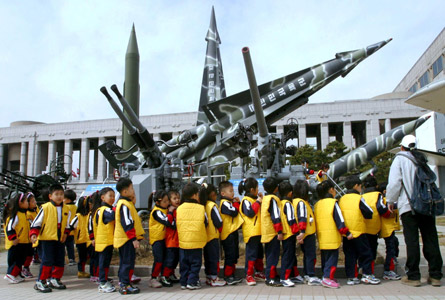North Korea has announced its intention to launch a satellite into polar orbit in mid-April as a tribute to the country's founder, Kim Il-sung.
The Kwangmyongsong-3 earth observation satellite will be launched by an Unha-3 rocket, purportedly an adaptation of the Unha-1 and -2 rockets used in two previous launch attempts.
Kwangmyongsong-1 and -2, the satellites launched on previous flights, were said to be experimental communications satellites designed to broadcast patriotic songs from low earth orbit. Despite Pyongyang's claims that both previous launches resulted in successful orbits, neither the US Air Force, which tracks space objects, nor independent researchers have located the North Korean satellites.
 |
|---|
| © Rex Features Are North Korea's space plans a cover to develop long-range ballistic missiles? |
"The obvious interpretation is they are using this as a cover to develop long-range ballistic missiles," says James Moltz, a professor at the Naval Postgraduate School in Monterey, California. "There is a minority opinion that North Korea is interested in developing low-cost space access for international customers. I find this hard to believe."
David Wright of US pressure group the Union for Concerned Scientists (UCS) says North Korea "essentially had a Nodong missile as a first stage", referring to a locally built version of the Soviet Scud missile. "We know North Korea had [acquired] some Scud missiles, taken them apart and figured out how they worked. There is an ongoing question about whether they figured out how to scale them up or had Russian help to develop these things."
The second stage, says Wright, seems to closely resemble the SS-N-6, a Soviet submarine-launched ballistic missile. The third and final stage appears to be adapted from small directional thrusters on the same missile.
"The technology they are using for this launcher is the same they would use for a long-range missile," he adds.
The launch announcement comes days after a deal was struck to open North Korea's nuclear facilities for international inspection in return for US food aid. The deal included an agreement not to conduct long-range missile tests, and the USA has threatened to suspend the agreement if a launch is carried out. North Korea has often reneged on its promises, using military technology or prowess to signal its displeasure with previous agreements.
"I think they are testing the water," says Moltz. "They are trying to push for as much as they can, and at the same time trying not to alienate China or other supporters.
"If this is an attempt to extort more food aid, it is a very stupid attempt."
The launch is viewed abroad as provocative. South Korea, which has been engaged in an uneasy standoff with its neighbour since the unofficial end of the Korean War the 1950s, condemns the satellite launch as a cover for ballistic missile tests - a way to experiment with prohibited weaponry while nominally sticking to recent commitments.
Japan has announced that it may shoot down anything that overflies its territory, despite North Korea's stated intent to launch to the south. The 1998 Unha-1 was launched eastwards and crossed the northern tip of Japan.
China and Russia, which are thought to exert significant influence over North Korea, have both publicly cautioned against the test.
Moltz says the two previous launch vehicles "were literally Sputnik-type systems, with a tape recorder and a small VHF antenna". He adds: "It was really 1950s technology. In the second launch, they showed a similar system. It was very clear it was very backward."
The satellite technology was of a similar vintage. Sputnik, the first man-made object ever placed into orbit, was a simple system, using beeps audible to radio listeners to display Soviet technical might. China's first satellite broadcast patriotic songs.
The UCS's Wright says: "The [North Korean] claim is that this satellite is going to be a little bit more sophisticated, that it will have a camera that will look at the ground. That is not a difficult thing to do, given that digital cameras are lightweight and easy to get hold of."
Moltz adds: "What we don't see any evidence of is any attempt to manufacture satellites and launch them on other people's rockets, which is a very normal stepping stone for a country that wants to develop a space programme. The fact that North Korea has not followed that route - and clearly they would have had opportunities to launch their own satellites on Chinese rockets - suggests their motivations are more closely linked to missile development than satellite development."
Source: Flight International


























